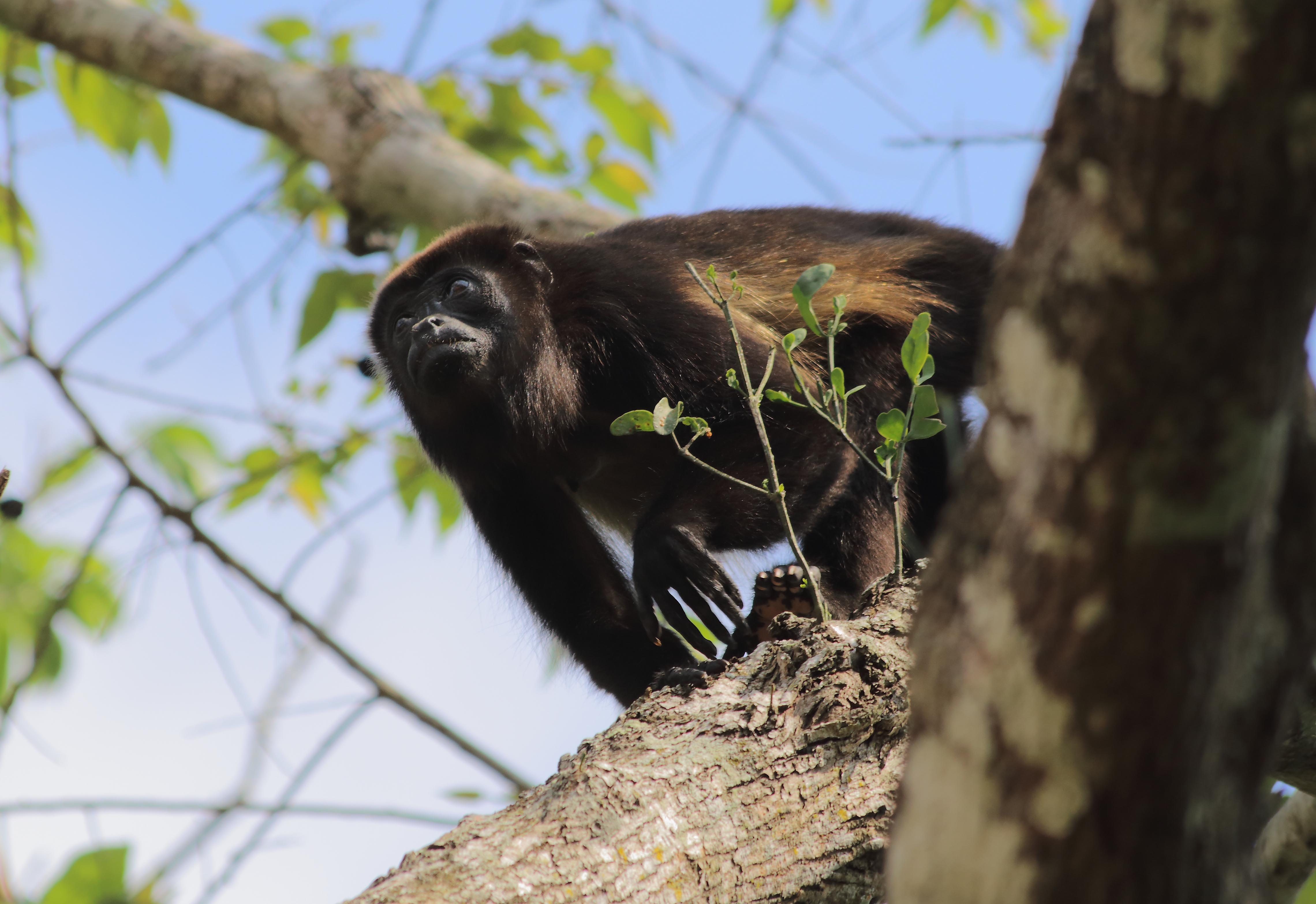Resumen
El mono congo, Alouatta palliata, ha sido ampliamente estudiado a lo largo de su distribución en zonas bajas, pero los estudios en ecosistemas de montaña no son muy numerosos. El presente estudio se realizó en las faldas del volcán Rincón de la Vieja, aproximadamente a 700 msnm, en un área compuesta por una mezcla de remanentes de bosques primarios y secundarios y pasturas dedicadas a la ganadería, con fuerte actividad turística. Se estudió una tropa de la que se evaluó su tamaño, ámbito de hogar, movimientos diarios, comportamiento, uso de hábitat y dieta. Se encontró que el descanso fue la actividad predominante, así como una relación significativa entre el movimiento y la alimentación. A su vez, seis especies de plantas fueron reportadas dentro de la dieta de la especie, existiendo preferencia por Garcinia intermedia, la parte más consumida fueron las hojas tiernas. Se estimó un ámbito de hogar de 889.16 m2 y un promedio de 516 m recorridos diarios durante el tiempo de estudio. Tres de los cuatro hábitats disponibles fueron usados en una alta proporción con respecto a su disponibilidad. Los resultados difieren poco con poblaciones de estudios previos en zonas bajas y en hábitats con menor presión, indicando que es posible que la visitación turística no tenga una influencia significativa sobre las tropas de la especie en hábitats perturbados.
Citas
Altmann, J. 1974. Observational study of behavior: sampling methods. Behavior, 49:227-267.
Cristóbal-Azkarate J. y V. Arroyo-Rodríguez. 2007. Diet and activity pattern of howler monkeys (Alouatta palliata) in Los Tuxtlas, Mexico: effects of habitat fragmentation and implications for conservation. American Journal of Primatology,69: 1013-1029.
Baumgarten, A. y B. Williamson. 2007. Distribution of the Black Howler Monkey (Alouatta pigra) and the Mantled Howler Monkey (A. palliata) in their contact zone in Eastern Guatemala. Neotropical Primates, 14:11-18.
Bolt, L.M., C.M. Hadley y A. L. Schreier. 2022. Crowded in a fragment: high population density of Mantled Howler Monkeys (Alouatta palliata) in an anthropogenically disturbed Costa Rican Rainforest. Primate Conservation, 36:1-9.
Bolt, L. M., D. G. Russell y A. L. Schreier. 2021. Anthropogenic edges impact howler monkey (Alouatta palliata) feeding behaviour in a Costa Rican rainforest. Primates, 62:647–657.
Chapman, C. 1987a. Patch use and patch depletion by the spider and howling monkeys of Santa Rosa National Park, Costa Rica. Behavior, 105:99-114.
Chapman, C. 1987b. Flexibility in diets of three species of Costa Rican primates. Folia primatologica, 49:90-105.
Chapman, C., L. Fedigan y L. Fedigan. 1988. A Comparison of transect methods of estimating population densities of Costa Rican primates. Brenesia, 30:67-80.
Clarke, M., C. Crockett, E. Zucker y M. Zaldivar. 2002. Mantled howler population of hacienda La Pacifica, Costa Rica, between 1991 and 1998: effects of deforestation. American Journal of Primatology, 56:155-163.
Cortes-Ortíz, L., M. Rosales-Meda, K. Williams-Guillén, D. Solano-Rojas, P.G. Méndez-Carvajal, S. de la Torre, P. Moscoso, V. Rodríguez, E. Palacios, D. Canales-Espinosa, A. Link, D. Guzman-Caro and F.M. Cornejo. 2021. Alouatta palliata (amended version of 2020 assessment). The IUCN Red List of Threatened Species 2021: e.T39960A190425583. https://dx.doi.org/10.2305/IUCN.UK.2021-1.RLTS.T39960A190425583.en. Accessed on 03 August 2023.
Crockett, C. y J. Eisenberg. 1987. Howlers: variations in group size and demography. Pp. 54-68, en: Primate Societies (Smuts B.B., D. Cheney, R. Seyfrath, R. Wrangham, y T. Struhsaker, eds.). The University of Chicago Press, Chicago.
Di Fiore, A. y C.J. Campbell. 2007. The atelines: Variation in ecology, behavior, and social organization. Pp. 155-185, en: Primates in Perspective (Campbell, C.J., A.F. Fuentes, K.C. MacKinnon, M. Panger y S. Bearder, eds.). Oxford University Press. Oxford.
Emmons, L.H., y F. Feer. 1999. Neotropical rainforest mammals: A field guide. Second Edition. Chicago, IL, United States: The University of Chicago Press.
Estrada, A. 1999. Feeding and general activity patterns of a howler monkey (Alouatta palliata) troop living in a forest fragment at Los Tuxtlas, Mexico. American Journal of Primatology, 48:167-183.
Estrada, A. y R. Coates-Estrada. 1991. Howler monkeys (Alouatta palliata), dung beetles (Scarabaeidae) and seed dispersal: ecological interactions in the tropical rain forest of Los Tuxtlas, Mexico. Journal of Tropical Ecology, 7:459-474.
Estrada, A. y R. Coates-Estrada. 1996. Tropical rain forests fragmentation and wild populations of primates at Los Tuxtlas, Mexico. International Journal of Primatology, 17:759-783.
Fedigan, L., L. Fedigan y C. Chapman. 1985. A census of Alouatta palliata and Cebus capucinus monkeys in Santa Rosa Nacional Park, Costa Rica. Brenesia, 23:309-322.
Freese, C. 1976. Censusing Alouatta palliata, Ateles geoffroyi and Cebus capucinus in the Costa Rican dry forest. Pp. 6-9, en: Neotropical primates, field studies and conservation. (Thorington Jr. R.W. y P. G. Heltne, eds.) Proceedings of a symposium on the distribution and abundance of neotropical primates, National Academy of Science. Washington D.C., US
Glander, K.E. 1975. Habitat and resource utilization: an ecological view of social organization in mantled howling monkeys. PhD Dissertation. University of Chicago.
Glander, K.E. 1978. Howling monkeys feeding behavior and plant secondary compounds: a study of strategies. Pp. 561-574, en: The ecology of arboreal folivores (G Montgomery, ed.). Instituto Smithsonian, Washington.
Holdridge, L. 1974. Ecología: basada en zonas de vida. IICA. San José, Costa Rica.
Kinsey, W. 1997. Alouatta. Pp. 174-185, en: New world primates: Ecology, evolution and behavior (Kinsey W, Ed.). Aldine de Gruyter. Nueva York.
Lambert, J. 1998. Secondary metabolites in Pentacletra macroloba: a dominant canopy species fed on by mantled howling monkeys (Alouatta palliata) in northeastern, Costa Rica. Brenesia, 49-50:103-108.
Lippold, L. 1988. A census of primates in Cabo Blanco absolute nature reserve, Costa Rica. Brenesia, 29:101-105.
Lippold, L. 1989. A wet season census of primates in Cabo Blanco absolute nature reserve, Costa Rica. Brenesia, 31:93-97.
Lippold, L. 1990. Primate population decline at Cabo Blanco absolute nature reserve, Costa Rica. Brenesia, 34:145-152.
Milton, K. 1980. The foraging strategy of howler monkeys: a study in primate economics. Universidad de Columbia. New York.
Ostro, L., T. Young, S. Silver y F. Koontz. 1999. A geographic information system method for estimating home range size. Journal of Wildlife Management, 63:748-755.
Ramírez-Orjuela, C. y I.M. Sánchez-Dueñas. 2005. Primer censo del mono aullador negro (Alouatta palliata aequatorialis) en el Chocó Biogeográfico Colombiano. Neotropical Primates, 13:1-7.
Reid, F. 1997. A field guide to mammals of Central America and Southeast Mexico. Universidad Oxford. New York.
Rodríguez-Matamoros, J., F. Villalobos-Brenes y G. A. Gutiérrez-Espeleta. 2012. Viabilidad poblacional de Alouatta palliata (Primates: Atelidae) y Cebus capucinus (Primates: Cebidae) en el Refugio de Vida Silvestre Privado Nogal, Sarapiquí, Heredia, Costa Rica. Revista de Biología Tropical, 60:809-832.
Sánchez, R. 1991. Utilización del hábitat, comportamiento y dieta del mono congo (Alouatta palliata) en un bosque premontano Húmedo, Costa Rica. Tesis de Maestría, Universidad Nacional, Heredia, Costa Rica.
Schreier, A.L., L.M. Bolt, D.G. Russell, T.S. Readyhough, Z.S. Jacobson, C. Merrigan-Johnson y E.M.C. Coggeshall. 2020. Mantled howler monkeys (Alouatta palliata) in a Costa Rican forest fragment do not modify activity budgets or spatial cohesion in response to anthropogenic edges. Folia Primatologica, 92:49-57.
Silver, S.C., L.E.T. Ostro, C.P. Yeager, F.W. Koontz y R. Horwich. 1998. The feeding ecology of the black howler monkey (Alouatta pigra) inNorthern Belize. American Journal of Primatology, 45: 263-279.
Stoner, K. E. 1994. Population density of the mantled howler monkey (Alouatta palliata) at La Selva Biological Reserve, Costa Rica: A new technique to analyze census data. Biotropica, 26:332-340.
Terborgh, J. 1983. Five New World Primates: A study in comparative ecology. University of Princeton. New Jersey.
Trygstad, H. 1991. A comparison of daily activity, diet, daily distance traveled, and habitat utilization of two troops of Mantled howler monkeys (Alouatta palliata) in curu wildlife refuge, Costa Rica. Associated Colleges of the Midwest.
Van Belle, S. y A. Estrada. 2008. Group size and composition influence male and female reproductive success in black howler monkeys (Alouatta pigra). American Journal of Primatology, 70:613-619.
Vergeest, F. 1992. The influence of tourism on the mantled howler monkey (Alouatta palliata) in Cabo Blanco, Costa Rica. Wagenigen Agricultural University. Holanda.
Williams, H. y C. Vaughan. 2001. White-faced monkey (Cebus capucinus) ecology and management in neotropical agricultural landscapes during the dry season. Revista de Biología Tropical, 49:1199-1206.
Williams-Guillen, K., C. Mccann, J. C. Martínez Sánchez y F. Koontz. 2006. Resource availability and habitat use by mantled howling monkeys in a Nicaraguan coffee plantation: can agroforests serve as core habitat for a forest mammal? Animal Conservation, 9:331-338.
Zucker, E., C. Clarke, K. Glander y N. Scott. 1996. Sizes of home ranges and howling monkeys’ groups at hacienda La Pacifica, Costa Rica: 1972-1991. Brenesia, 45-46:153-156.

Esta obra está bajo una licencia internacional Creative Commons Atribución-NoComercial-SinDerivadas 4.0.
Derechos de autor 2023 UNIVERSIDAD NACIONAL AUTÓNOMA DE MÉXICO




